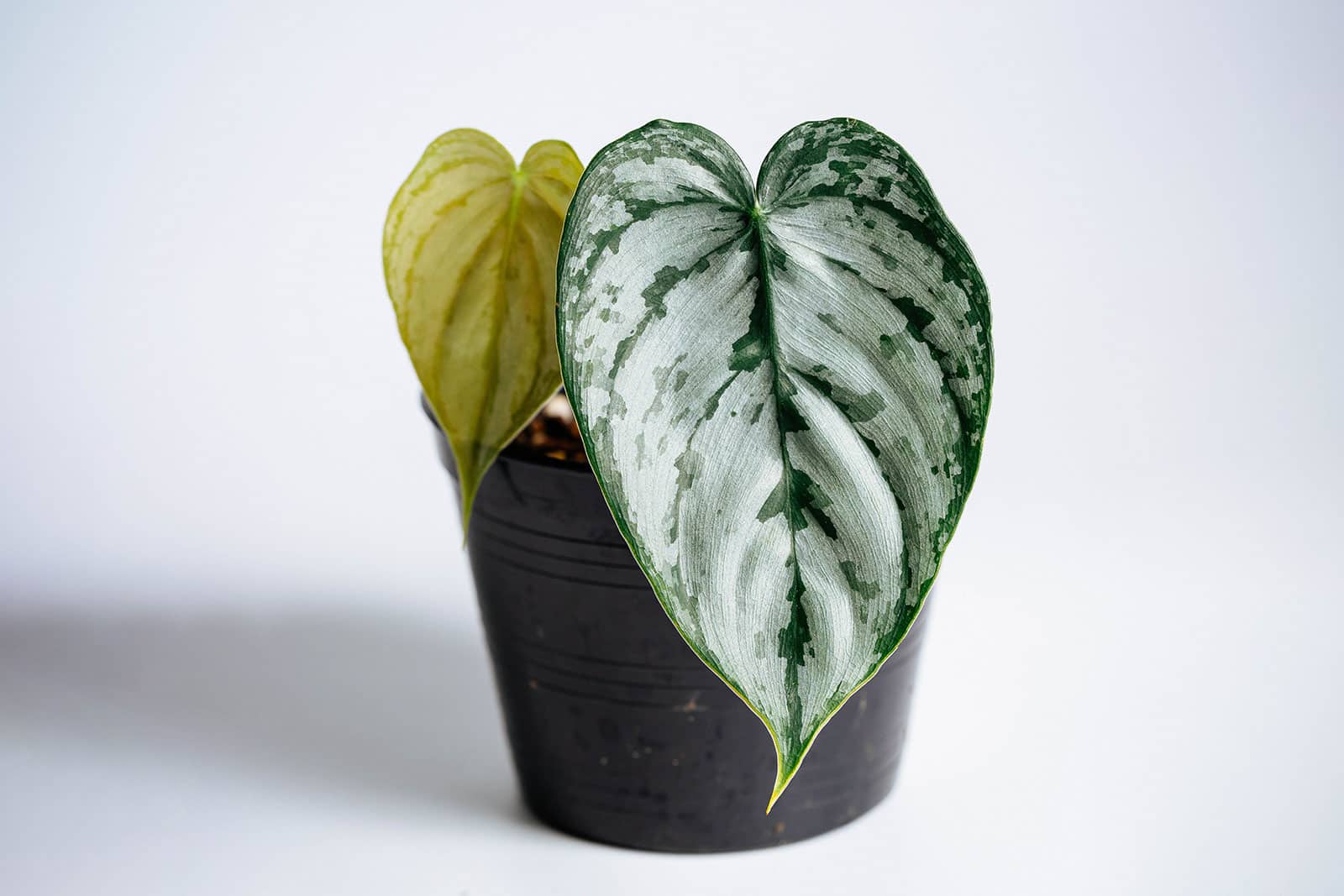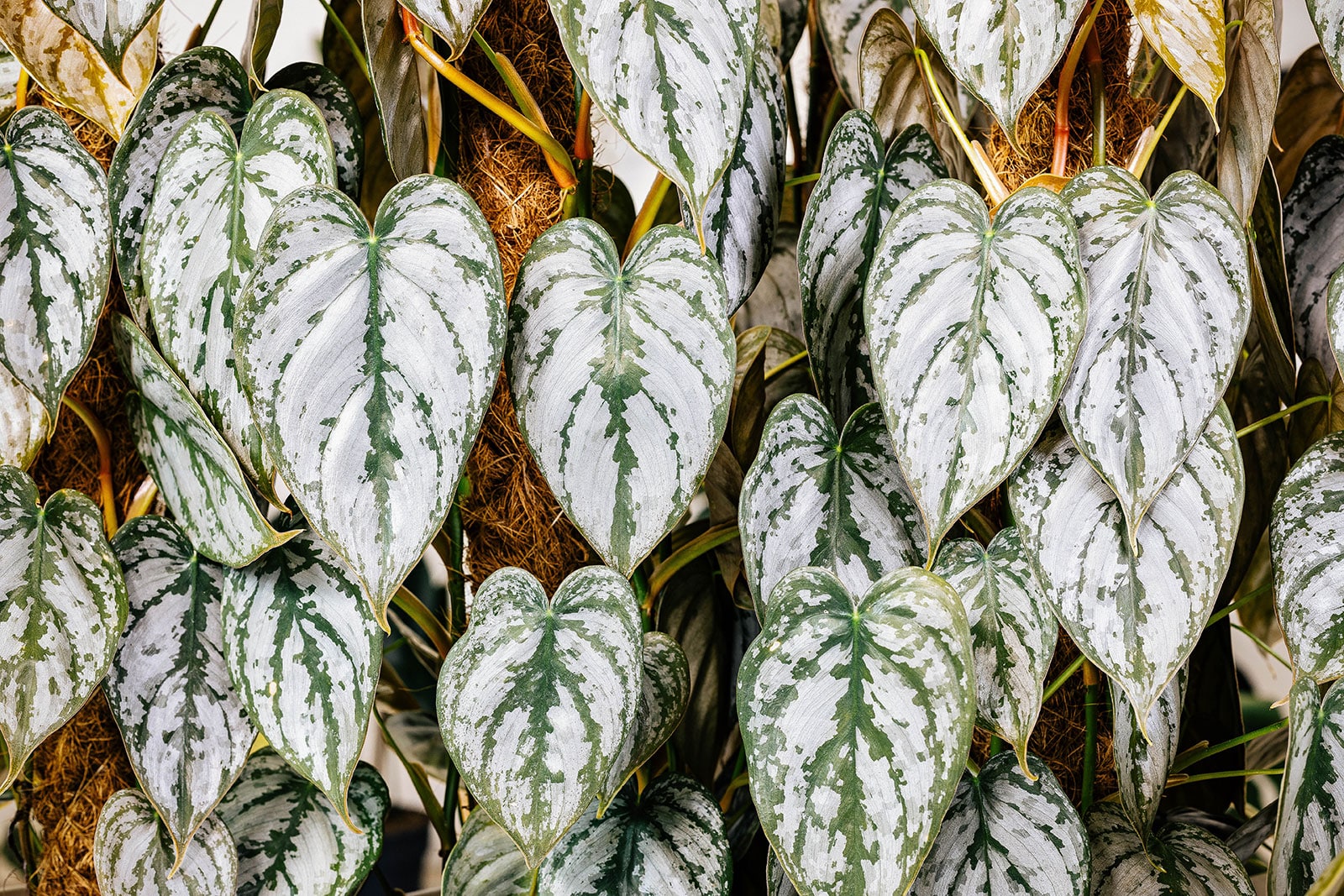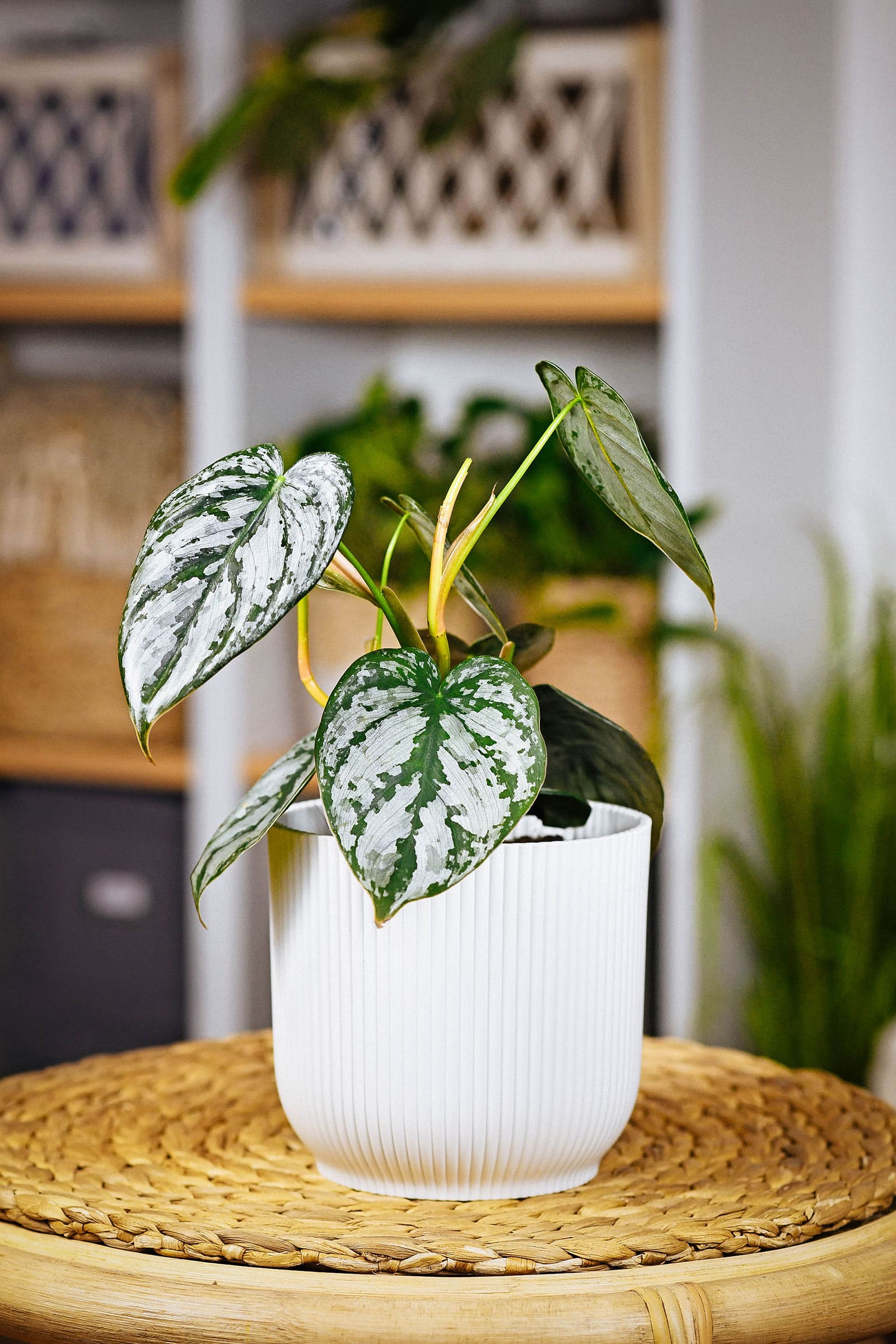The genus Philodendron is one of the most common in the houseplant hobby—not surprising, considering it contains almost 500 species of plants.
Read more: My Favorite Philodendron Varieties That You’ll Love Too
Today, let’s have a look at one of my personal favorites: the striking Philodendron brandtianum, also known as Philodendron ‘Brandi’ or the silver leaf Philodendron.
Once rare, this species is now becoming easier to find (and cheaper, too!), so it’s about time for a proper plant care guide to help yours stay healthy and beautiful.
Keep reading for everything you need to know about Philodendron brandtianum, its origins and how to care for it in your home!
| Common name(s) | Silver leaf Philodendron, Philodendron ‘Brandi’ or ‘Brandy’ |
| Scientific name | Philodendron brandtianum |
| Family | Araceae |
| Height and spread | Up to 10 feet high and 3 foot wide |
| Light | Bright indirect |
| Soil type | Aroid soil |
| Water | Keep lightly moist |
Disclosure: If you shop from my article or make a purchase through one of my links, I may receive commissions on some of the products I recommend.

About Philodendron brandtianum
Description
Philodendron brandtianum is generally referred to by its scientific name, but it does have a common one as well: silver leaf Philodendron, which also explains its appeal to so many houseplant enthusiasts. Young plants display spectacular green and silvery mottled coloration on their heart-shaped leaves.
Older specimens of P. brandtianum grow narrower, much larger foliage with only light silver spotting. In fact, they look so different from their juvenile counterparts that it can be difficult to recognize them at all if you don’t know what you’re looking for!
A member of the aroid family, this is a vining species that’s perfectly adapted to clinging to trees in its natural habitat. If you allow yours to climb, it can grow very tall, eventually reaching heights of 10 feet or more.
Did you know? As if green and silver wasn’t striking enough, new leaves on Philodendron brandtianum emerge orangey in color. They take on their normal mottled coloration after a week or two.
Where to buy Philodendron brandtianum plants:
Philodendron brandtianum vs. Scindapsus pictus
If you’re not a houseplant expert, it can be difficult to correctly identify Philodendron brandtianum. It bears close resemblance to a bunch of other common aroid houseplants, especially the popular satin Pothos/silver Philodendron (which, confusingly, is neither a Pothos nor a Philodendron—it’s known scientifically as Scindapsus pictus).
Although both these species are vining plants known for their dark green leaves with silver mottling, it is possible to spot the difference.
There’s the leaf texture, for starters. While Scindapsus pictus is known specifically for its matte, satiny foliage, the leaves on Philodendron brandtianum are smooth and have a more leathery feel to them.
Additionally, the mottling on Scindapsus leaves is more scattered than on the Philo (at least when the latter is young), whose green coloration is mostly found on the leaf veins.
Mature Scindapsus plants also have more rounded foliage than their Philodendron cousins, whose leaves grow more elongated with age and have more pronounced leaf veins.
Did you know? Other plants that are similar to Philodendron brandtianum include Philodendron sodiroi and P. mamei, both of which also have silvery variegated leaves. Their growth patterns are a little different, though, and you’re unlikely to come across either of these species in your local plant store.
Natural habitat
Like many of our favorite houseplants, Philodendron brandtianum is naturally found in South America. It occurs in Colombia, Brazil, and Bolivia, where it has adapted perfectly to life in the tropical rainforest, using taller trees for support as it climbs towards the forest canopy in search of more light.
Unlike many other Philodendrons, which favor wet tropical climates, P. brandtianum is found in seasonally dry biomes. That’s good news for us houseplant enthusiasts, as it means it’s a little more forgiving in terms of watering than many of its cousins.

Caring for Philodendron brandtianum
Light and temperature
In terms of light and temperature requirements, Philodendron brandtianum is a standard tropical. Although it may be able to take a little more direct sun than its cousins from wet tropical biomes—seasonally dry tropical forests are often (partly) deciduous, meaning more light reaches the plant during at least part of the year—it can still burn if it’s not properly acclimated.
For the best results, give your plant a spot in the home that receives bright but indirect light. Don’t keep it in the shade, as that can cause the beautiful silvery leaf markings to fade.
Although room temperature or above is ideal for your silver leaf Philodendron, it should be fine with anything over 60°F. Its growth may slow down or stop if things get too chilly, and freezing temperatures are fatal.
Water and humidity
Philodendron brandtianum does best when its soil is kept lightly moist. I unfortunately can’t tell you how often to water, as that depends entirely on factors like light, temperature, and soil composition, but there are some handy rules of thumb that you can keep in mind.
During the warm summer months, when your plant is hopefully actively growing, let the first 2 inches or so of the soil dry out before watering again. In winter, when your Philo is likely mostly inactive, it needs less moisture. You can leave the soil to dry about halfway.
Humidity-wise, the ideal for a plant like this one is 80 percent or higher. In most places you’d need a greenhouse or humidity cabinet to achieve this, but since most folks don’t have one around, you can try to aim for 50 percenet or up. If the air moisture levels in your home regularly drop below that, you may want to consider investing in a humidifier.
Tip: When it comes to watering, it’s usually better to err on the side of caution. Although consistent underwatering can cause issues, it’s less problematic than rot caused by overwatering, especially for a plant that should be adapted to the occasional “drought”!
Soil and planting
One nice thing about climbing aroids like this one is that most of them like the same type of soil.
The ideal mixture has a few different ingredients, but it’s easy enough to put together and suitable for a whole bunch of species: other Philodendron varieties (like Philodendron gloriosum, ‘Birkin’, and ‘Pink Princess’), Monsteras (like Monstera siltepecana and ‘Thai Constellation’), and even the so-called Mini Monstera known as Rhaphidophora tetrasperma.
Every houseplant lover swears by a slightly different composition, but a great basic aroid soil mixture that will work well for your Philodendron brandtianum can look a little like this:
- 3 parts potting soil
- 1 part perlite
- 1 part fine orchid bark
If you find the soil dries out too quickly for your liking, you can also add a handful of sphagnum moss. If you feel it needs better drainage, just up the perlite or the bark.
Although Philodendron brandtianum is often sold as a hanging type plant, it’s actually naturally a climber. To see yours in its full glory, it’s preferable to give it a moss pole or plant totem, rather than keeping it in a hanging pot and letting its vines dangle down.
Simply attach the stems to the pole and your Philo will know what to do, clinging closely to its support and gradually growing larger leaves.
Tip: Don’t forget to always use a planter with a drainage hole. Although Philodendron brandtianum appreciates moisture, standing water can be a death sentence.
Recommended products for Philodendron brandtianum plant care:
- Good Earth Organics Premium Potting Soil
- Perfect Plants Organic Perlite
- Better-Gro Orchid Bark
- Better-Gro Orchid Moss
- Totem Monkey Extendable Coir Moss Poles
Fertilizing
Philodendron brandtianum is not a heavy feeder, but it will appreciate a little fertilizer nonetheless. During the growing season (late spring to early fall in most areas), apply some diluted balanced houseplant fertilizer once or twice a month.
Stop fertilizing during winter or if your plant is not actively growing. Its roots won’t be able to use the nutrients, and they can actually end up suffering instead.
Recommended fertilizers for Philodendron brandtianum:
- Elm Dirt Plant Juice Organic Fertilizer
- Houseplant Resource Center Liquid Fertilizer for Houseplants
- Instant Biologics Instant Plant Food (Fizzing Nutrient Tablets)
Pruning
Pruning a Philodendron brandtianum generally shouldn’t be necessary, although you can of course remove dead or unsightly leaves.
If you do decide to prune (like if your plant has become too tall for your liking), be sure to have a look at the section on propagation below to find out how to grow a brand new Philo for free using the clippings.
Dividing or repotting
Because this species doesn’t tend to produce many offsets, it’s not the ideal candidate for division. Instead, if your Philodendron brandtianum has outgrown its planter, it’s best to move it one pot size up.
Repotting is ideally done during springtime, and it’s also a good time to refresh your plant’s soil.
Really don’t want to go for a bigger pot? Although it’s not my favorite option, it’s also possible to prune your Philo’s stems and roots somewhat, helping to keep it more manageable. The plant might sulk for a few weeks after such an invasive operation, but with the right care, it should perk back up eventually.

Propagating Philodendron brandtianum
One of the great things about vining climbers like this species is that they’re a breeze to multiply. Propagating Philodendron brandtianum can be as simple as snipping a piece of stem with some leaves off an existing plant and placing them in water for a few weeks to root!
After this, you can pop the rooted cutting into some suitable soil and voilà, you’ve got a whole new Philodendron Brandi.
If you prefer not to propagate in water, you can also plant your cutting directly in soil, pure perlite with a layer of water, or moist sphagnum moss. Keep the medium lightly moist and be sure to put the whole thing in a nice and warm (but not sunny) location for the best results.
Keep in mind that propagating any houseplant can take significantly longer during the cool and dark winter months than in summer. Just be patient; as long as the cutting isn’t dying off, it can still root.
Is Philodendron brandtianum toxic to cats and dogs?
Like other members of the family Araceae, Philodendron brandtianum is considered mildly toxic. This is due to the presence of calcium oxalate crystals in the leaves, which can cause swelling and irritation to the lips and mouth when chewed.
So while you won’t have to worry about your furry friend being seriously harmed if it gets into your Philodendron, it’s still best to keep this plant out of their reach to prevent issues.
Source:
https://powo.science.kew.org/taxon/192982-2















